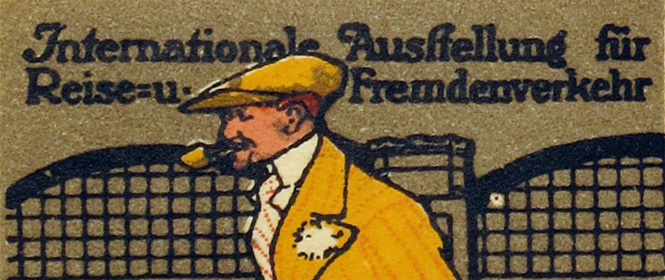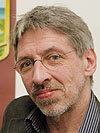
The rise of tourism
For more than half a century, the ITB travel show has been held every March in Berlin. From modest beginnings, ITB has grown to become the world’s largest exhibition in what is probably now the world’s largest industry. The competition is fierce, with tourism-related fairs held in more than 70 countries. Germany leads the way, with no less than 40 such major events. It’s no coincidence that Germany – and Berlin in particular – is so active in this area. Indeed, there is a long tradition that can be traced all the way back to the German Reich, as Prof. Dr. Hasso Spode explains.
The first ‘Exhibition for Travel and Tourism’
On 18 March 1911, the world’s first tourism fair – the ‘International Exhibition for Travel and Tourism’ – opened its doors at the Berlin Zoo trade fair grounds (roughly on the site of what is now BIKINI BERLIN). Almost a dozen countries were represented, from Norway to Austria–Hungary. The patron of the show was the distinguished global traveller Adolf Friedrich zu Mecklenburg, who later went on to serve as the Governor of Togo. It was organised by the Verband Berliner Kaufleute und Industrielle (Association of Berlin Merchants and Industrialists). The visionaries behind the event recognised the potential offered by tourism in a globalised world.
The German Empire: travel for a privileged few
This was the golden age of elite tourism. Resourceful tour operators, especially Thomas Cook & Son, offered sophisticated packages. For example, the firm operated a cable car on Mount Vesuvius. What’s more, colossal cruise ships crossed the oceans, from Samoa to Spitzbergen – with Hapag leading the way in this area. However, it was also easy to travel under your own steam. Borders were no obstacle, passport and visa requirements had more or less been abolished, suites in the local grand hotel could be booked by telegraph and a network of luxury trains connected large cities with holiday resorts. There was a good reason why people talked about ‘pan-European travel’. Whether Nice, Biarritz, Ostende, Baden-Baden, Ischl or Interlaken: sophisticated spa and coastal resorts saw aristocrats and captains of industry rub shoulders with high-ranking officials, military top brass, artists and scientists. Well-heeled bourgeois families also liked to travel. They and their children would pack their bags for summer resorts, with the men crossing the mountains like ‘backpackers’. The most popular destination was Switzerland, a country that had made a fortune through tourism. Word soon travelled, of course: thousands of ‘travel clubs’ were established in 1900 or thereabouts, with many of them represented at the Berlin fair. ‘One of the peculiarities of our age is mass tourism,’ remarked Theodor Fontane. He was, however, referring to his own bourgeois circles. ‘Mass tourism’ simply wasn’t an option for 90 per cent of Germans, who had neither the time nor the money for such a luxury.
The Weimar years: tourism afflicted by isolationism and economic crisis
The glittering dream of ‘pan-European travel’ vanished with the First World War. National isolationism was now the order of the day, with holidays at home seen as a ‘patriotic duty’. And the holiday resorts were no longer populated with the traditional bourgeoisie, but with clerks and teachers. One grand hotel after another went bankrupt. The ‘era of the six-week recreational holiday’ was over, as Tucholsky pointed out. The industry attempted to offset the decline in ‘paying guests’ by offering cheap ‘holidays for the people’ for around one hundred Reichsmarks each. Nevertheless, holidays remained the preserve of the ‘better off’, although labourers (who accounted for about half of the working population) now also benefited from a holiday entitlement. Often, however, they were only given a holiday allowance of three days a year and, with a monthly wage of less than 200 Reichsmarks, they didn’t have enough money for a ‘people’s holiday’.
Kraft durch Freude (‘Strength through Joy’) in the Nazi era
The Nazis made it their aim to ‘break down the bourgeois privilege of travel’. On 17 February 1934, special trains, bedecked with flags, rolled through the country, as 10,000 ‘worker holidaymakers’ were sent on holiday – a huge propaganda coup. ‘Nazis send workmen to Alps for vacation,’ reported the New York Times, incorrectly stating that there were only a thousand holidaymakers. Nevertheless, the paper expressed its astonishment that wages were not stopped during the one-week break. The spectacle was organised by the partly state-operated Nazi leisure organisation Kraft durch Freude (KdF). With a dramatic improvement in workers’ holiday entitlements, social tourism became a cornerstone of ‘socialism in deed’, which was designed to distract the rebellious proletariat from notions of class warfare: in other words, travel was a means of compensating for the loss of human and collective bargaining rights. In the very same year, KdF sold half a million holidays, with an average price of 35 Reichsmarks. The price plunge was mostly due to conveyor belt methods. This was the first time that holidays were produced on an industrial scale; KdF came from nowhere to become the world’s largest tour operator, far ahead of Thomas Cook. In the years leading up to the war, the organisation put together more than 37 million short breaks, sending seven-and-a-half million Germans on holiday; 700,000 of them even went on a cruise with the KdF fleet. The images of German workers sunning themselves on the decks of luxury liners caused a splash, both at home and abroad.
1960s: mass tourism takes off
All the propaganda hype papered over the fact that – despite remarkable successes in certain areas – there had been no seismic shift in the social order: holidays still remained a pastime of the upper and middle classes. It wasn’t until the 1960s that the ‘mass tourism’ described by Fontane gradually became social reality in both East and West Germany. Even lower earners started gaining increasing access to tourism. At the same time, a new process of globalisation was coming to the fore, and tourism was preparing to become a major force in the global economy. Against this background, a tourism fair was once again held in West Berlin in 1966, albeit a more modest one than in 1911: the inaugural ITB comprised nine exhibitors from five countries – in 2017, there are over 10,000 exhibitors from 187 countries, with only six UN member states not represented.

© FU Berlin |
Prof. Dr. Hasso SpodeProfessor Hasso Spode is a historian and sociologist. He manages the historical tourism archive at Technische Universität Berlin (Willy Scharnow Archive) and teaches at Leibnitz Universität Hannover. He is a co-publisher of the Annals of Tourism Research and a co-founder of Voyage. Studies of Travel & Tourism; he has more than 200 scientific publications to his credit (www.hasso-spode.de). Recent books include: Ressource Zukunft. Die sieben Entscheidungsfelder der deutschen Reform, Opladen 2009 and Mobilitäten!, Berlin 2014 (as publisher). |